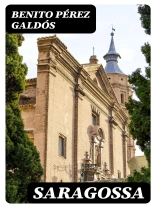In ‘Saragossa’, Benito Pérez Galdós intricately weaves a tapestry of narratives that reflects the socio-political turbulence of 19th-century Spain. Employing a realist literary style characterized by detailed characterizations and vivid descriptions, Galdós presents an immersive portrait of the city of Zaragoza amidst the backdrop of war and societal unrest. The novel eloquently explores themes of conflict, identity, and the human condition, skillfully navigating the intricate interplay of personal and collective experiences. The fragmented structure of the narrative, reminiscent of a mosaic, invites readers to piece together a broader understanding of life during this tumultuous period. Benito Pérez Galdós, a key figure in Spanish literature, was profoundly influenced by the cultural and political climate surrounding him. His works often reflect a deep empathy for the struggles of the common people and a fierce commitment to social realism. Having witnessed firsthand the effects of war and poverty, Galdós’s portrayal of Zaragoza serves not only as a backdrop but as a living character in its own right, shaping the lives and destinies of the protagonists within. ‘Saragossa’ is a must-read for those interested in Spanish literature, history, and the exploration of human nature. Galdós’s masterful storytelling and rich, nuanced characters invite readers to engage deeply with the text, rendering it a timeless exploration of resilience and identity that resonates with contemporary themes.
Over de auteur
Benito Pérez Galdós (1843–1920) stands as a towering figure in the pantheon of Spanish literature. Born in Las Palmas de Gran Canaria, he moved to Madrid where he would eventually emerge as one of the most prominent novelists of the 19th century, renowned for his realistic characterisation and deep social commentary. Galdós’s literary output was prodigious, best exemplified by his two grand series: ‘Episodios Nacionales, ‘ a sequence of historical novels depicting Spanish history from the 19th century, and the ‘Novelas españolas contemporáneas, ‘ offering incisive critiques of the societal issues of his time. His style, rooted in the tradition of Realism and tinged with Naturalist elements, aimed to be the Spanish equivalent to Balzac’s comprehensive human panorama. ‘Saragossa, ‘ one of his works, epitomises his narrative skill, as it weaves a captivating tale against the backdrop of the Spanish War of Independence. This portrayal is reflective of his gift for intertwining the personal with the historical, creating a tapestry rich in detail and empathy for the human condition. Galdós was nominated for the Nobel Prize in Literature on several occasions, an acknowledgment of his stature and his wide-ranging influence on not only Spanish literature but on the broader European literary landscape of the late 19th and early 20th centuries.












